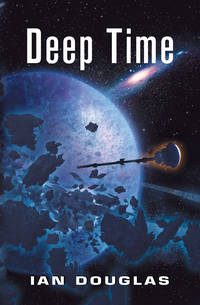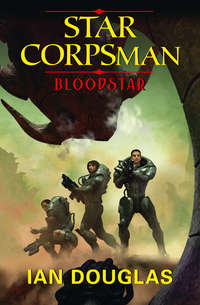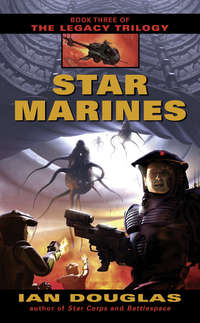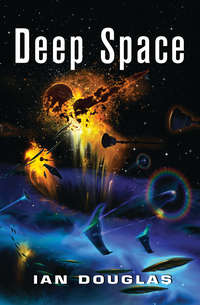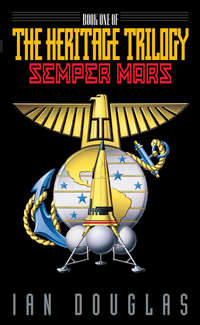
Полная версия
The Complete Heritage Trilogy: Semper Mars, Luna Marine, Europa Strike
“Fuentes will do it if anyone can, Mr. President.” Gray decided not to tell Markham that Carmen Fuentes was a woman. Sex had stopped being an issue in the American military decades ago, but even now there was the unspoken but very evident assumption in government and in the chain of command that a man was needed for a man’s work. So far as Gray was concerned, Fuentes had proved herself and then some at the US Embassy in Mexico City. Warhurst trusted her…and, more to the point, the men and women in her platoon trusted her. He wasn’t going to risk interfering with that.
He just hoped she had what it took to pull off her mission. Right now, it looked as though the very existence of the United States of America was hanging by a thread.
NINETEEN
TUESDAY, 12 JUNE: 1412 HOURS GMT
Star Eagle transport Michael
E. Thornton
LEO
0712 hours PDT
The Star Eagle Michael E. Thornton, a single-stage-to-orbit SCRAMjet transport, had cleared the lower reaches of Earth’s atmosphere and was accelerating now on her rockets, thundering through the fast-thinning traces of air toward the sunrise. Lieutenant Carmen Fuentes, encased in Class-One/Special armor and riding in what by now was effectively vacuum, couldn’t hear the rockets so much as feel them. The passenger module was a quick design that Marines jokingly referred to as “economy class,” with thin padding over hard steel skeletons of chairs.
It was not the most comfortable way to ride to orbit.
The last whispering rumble of the rocket engines died away, leaving Lieutenant Carmen Fuentes and the twenty-two men and women with her in the Star Eagle’s passenger compartment in the free-falling light-headedness of microgravity. The green light at the head of the compartment winked on, indicating that it was safe to move about. Fuentes unsnapped her harness, grabbed a handhold on the overhead, and pulled herself around to face her people.
“Listen up, everyone,” she said over the platoon channel. “I want all of you to stay strapped in. There’s nothing to see in this tin can, so you might as well stay buckled. You’ve all got your TD-patches, so you shouldn’t be spacesick. Any of you do feel sick, use your barf bags. Just remember, it’ll be a long time yet before we can unsuit.”
The passenger compartment for this flight of the Thornton was deliberately unpressurized, which meant the Marines had to stay sealed in their armor all the way up.
“I got the word a few minutes ago,” she continued, using the general talk frequency. “The McCutcheon’s lifted off from Florida and is on her way. We’ll have our backup at the target.”
She could almost sense the relief among the armored forms facing her. The Keith B. McCutcheon was another Star Eagle, identical to the Thornton, but she was coming to orbit with only a few Marines and technicians on board, riding in a pressurized passenger compartment. There would be doctors on board, and a small, microgravity surgery; most important, it would provide the Marine assault team with a place to go, shuck their suits, and stand down for a while. The op at the ISS was expected to take a long time, longer than their suits could carry them.
Fuentes resumed her seat. There were no windows, no display screens, and nothing to see but the cargo bay interior. From time to time, Thornton’s captain called back from the Star Eagle’s cockpit, updating her on their status.
“Lieutenant?” the ship’s captain said eventually. He was a Navy commander named Bryan Mason. “We’re coming up on the target. I’m cracking your overhead now. Make sure everybody’s tied down back there, and watch the light.”
“That’s a roger. We’re all secure here.”
“Copy. Opening up.”
Like the old shuttles, the Star Eagle possessed long, twin doors above the cargo area, and those were slowly opening now, the movement completely silent in the vacuum, though Fuentes could feel the vibration through the hull when she touched it with her glove. She looked up and watched the dark gray hatch panels sliding apart, revealing the inexpressibly lovely, deep blue of the Earth hanging above their heads. She glanced back down at her platoon, watching for the signs she’d been warned about…thrashing about, shaking, any of the possible physical reactions indicating that someone might be going into panic.
There were none. The platoon had been well briefed and well trained.
As the doors swung aside now, sunlight blasted into the interior, darkening the polarized visors of every Marine in the bay. Earth was impossibly blue, impossibly brilliant, a swirl of azure ocean, white dapplings and currents and sweeps of clouds, and a tawny patch of desert. Fuentes had thought she knew her geography well, but she found she couldn’t recognize any part of the planet suspended above her head.
“Range to target,” Commander Mason’s voice said in her headphones, “one hundred meters. We have hostiles in sight.”
“Roger that. Thanks for the ride.”
“Any time, Lieutenant. Fly Navy.”
“My Ass Rides In Navy Equipment, Sir,” she replied jauntily, using the old MARINES acronym. She switched to the platoon frequency. “Platoon! Unhook and disembark! By the numbers! First rank…go! Second rank…go! Third rank…”
Line by line, the Marines floated out of their seats, leaving belts and gleaming belt buckles magically adrift in zero G. Fuentes reached across with her right hand, touched the thrust control on her left arm, and felt the slight, upward nudge of her MMU’s high-pressure nitrogen jets.
Class-One/Special armor, as the designation suggested, was a special adaptation of standard full armor. The suit part was basically unchanged, hard-shelled and coated in active camouflage surfacing, with helmets made insectlike by the lenses of cameras and headlights arrayed just above the dark-tinted visors. The principal change was in the life-support backpack that each Marine wore like half of a mattress strapped to the armor’s back. Derived from the Manned Maneuvering Units of the early days of the Space Shuttle, these MMUs served as miniature, one-man spacecraft, providing power, life support, and maneuverability for up to twelve hours at a time.
As Fuentes cleared the passenger module, she touched another thrust control, canceling her upward momentum. She was hanging now twenty feet above the gaping cargo bay of the Star Eagle. Above and around her were the other twenty-two men and women of her platoon. Directly ahead was the International Space Station, a glittering structure of interconnected cylinders, cans, and spheres, stretched along spidery struts between the gorgeous black-purple spread of its winglike solar panel arrays.
Mason was right. She could see armored figures, dwarfed to near insignificance by the size of the ISS structure, moving along the struts. It looked like the UN troops—some of them, at any rate—had come out to play.
She saw a twinkling of tiny lights in the shadowed side of the ISS and realized with a curious detachment born of her eerie surroundings that they were firing at her.
“Space Strike One, this is Eagle,” Mason’s voice said. “We are taking projectile fire from the target. Be advised that Hellfire is in position to deliver covering fire.”
“Platoon!” she rasped out. “Watch your vision! Okay, Eagle. Let’s have that cover fire!”
Hellfire was Shepard Station, nudged from its lower, faster orbit to a position in the same orbit as the ISS, trailing it by about twenty kilometers. A moment later, a portion of the space station’s hull grew briefly, intolerably bright.
The ISS battle represented an odd balancing of forces and tactics. The station itself was unarmed, so the only way the defenders could hold off the Marines was to send armored troops outside and engage the attackers one-on-one. The Marines, in turn, were hampered by the fact that they couldn’t just find an airlock and smash their way in. It took time to cycle through a lock, and by the time a handful of Marines could squeeze into an airlock and match pressures with the station interior, they would find a large number of UN troops on the other side, waiting for them to crack in the inner hatch and start moving through one at a time.
Neither could the Marines simply find a spot on the side of the station, blow a hole through, and storm inside. There were at least eight hostages aboard, including five Americans. Fuentes’s orders stated bluntly that her first priority was to secure the station, but indiscriminately slaughtering hostages and enemy troops alike was not going to help the US cause much, any more than it would advance her own career.
The plan that they’d arrived at was a compromise at best, but one that offered a fair chance of success if they could clear the ISS framework of enemy troops. Unlike Shepard Station, the International Space Station was not powered by a nuclear reactor. All power came from the solar array, which converted sunlight directly to electricity and channeled it through a series of heavily shielded cables to the battery compartment at the station’s midships area. Fully charged, those batteries could keep the ISS powered for an estimated forty-eight hours, a time period that could be extended somewhat by shutting down nonessential systems.
The Marine plan depended on being able to clear the enemy from the station’s struts and rigging in order to gain unrestricted access to the power conduits from the solar panels. Cut those cables, and the station would be helpless, forced to draw on battery power for temperature control, communications, oxygen recycling, and scrubbing excess CO2 from the air. The problem, then, would be waiting them out. The UN troops could afford to sit tight knowing the Marines couldn’t storm inside and root them out; if the UN could get reinforcements to the station, the Marines would have to withdraw and the siege could be lifted.
And that, of course, was where Shepard and its laser came into the picture. Without reinforcements, sooner or later the ISS would have to surrender. And no reinforcements could approach the ISS so long as Shepard remained intact, with the Hecate HEL. In addition, Shepard could give the Marines a much-appreciated hand by sweeping snipers from the station’s struts and rigging. By timing the HEL pulses to a fraction of a second, the laser wouldn’t damage the station, but any enemy troops who happened to be looking in Shepard’s direction would be blinded.
“Forward, Marines!” Fuentes cried, touching her forward thrust control and holding it, letting her velocity build. There was no sensation of motion save for the slow growth of the ISS in her field of vision, and the steadily dwindling green numbers flickering on her visor HUD at the edge of her field of vision, counting down the meters as measured by her helmet’s laser ranger. Carefully, she unstrapped her ATAR, moving slowly to avoid going into a spin, and planted the rifle’s butt plate squarely in the slot built into the armor just about over her navel. She touched a button on the rifle’s side; a yellow crosshair appeared on the inside of her visor, together with a tiny, inset video image on her HUD’s lower left field.
What she was about to do ought to work, but it had never been tried before…at least, not outside of the microgravity combat training simulators at Vandenberg. She selected a target, a blue-helmeted soldier clinging to an antenna guy, and moved her rifle until the crosshair was centered on his chest.
Lightly, almost delicately, she squeezed the trigger.
Every action has an opposite but equal reaction, and a rifle firing in zero G acts precisely like a small rocket, hurling mass in one direction and kicking the shooter in the other. Each bullet’s mass was tiny compared to Fuentes and her hundred kilos-plus of armor and MMU, but moving very quickly, enough to give a noticeable recoil, enough to slow her forward velocity somewhat…but not enough to stop her or knock her off course. Most important, the center-of-mass-firing technique pioneered in the simulators at Vandenberg worked. If the rifle was badly positioned, the recoil could set her spinning. Careful firing from the center of mass, however, simply slowed her in her headlong charge. All of the Marines in the strike force had practiced firing from free-pivoting microgravity simulators, gangling contraptions made of struts and wires from which an armored Marine could dangle in a frictionless approximation of zero G.
She just hoped the rest of her Marines remembered their training. If one of them went spinning off into the void now, there’d be no way to recover him.
She’d been so concerned about not sending herself into a spin that she hadn’t noticed what had happened to her target. The man was tumbling away from the space station now, arms and legs cartwheeling, a fine white mist of freezing air trailing like a tiny contrail. A second blue-top appeared to her left, but she couldn’t fire at him without turning in place, a maneuver she wasn’t about to try now. She concentrated instead on the part of the ISS she was going to hit, a smooth, curved, surface that was growing from a piece of a Tinkertoy construct to a vast white wall dead ahead. She triggered reverse thrust, then fired off a burst from her ATAR for good measure, reducing her forward velocity to a slow drift.
She hit with a clang that resounded through her helmet, rebounded, and went into a slow, almost graceful spin. For a moment, panic struggled with training; there was no up or down, no easy means of orienting herself. Then as she’d been taught, she put out her left arm to counter the rotation; that slowed her down enough that she could grab a handhold, coming to a bouncing halt.
She’d made it. “Fuentes on target!” she called over the general com circuit. The idea was to keep everyone apprised of where everyone else was, but she could already tell that the sheer confusion of the situation was going to overwhelm any attempts at organization or battle management.
Turning herself about, she tried to reacquire the UN trooper she’d glimpsed on the way in, but she was confused. Not that way…damn! He could be behind her for all she knew. She turned again. The sky was filled with incoming Marines; a few blue-tops clung to station rigging or used handheld jets of some kind to propel themselves along the station’s length toward one of the airlocks. Earth was enormous, a blue-white arc across half the sky. Over her headset, she could hear the crackling calls of her Marines.
“Wheeoo! Comin’ in!”
“Watch it, Sandy! Bad guy on your four o’clock!”
“I got him!”
“I’m down! Ortega on target!”
“Help me! This is Kelly! I’ve got a malfunction! Someone help me!”
She looked around for Private Kelly but couldn’t see him. The battle was a tangle of confusion, with unfamiliar shapes and movement in unexpected directions. She had an excellent vantage point, midway along the length of the ISS, somewhere in the vicinity, she thought, of the computer module. The station’s keel—a massive structure of zigzagging struts and long, aluminum beams supporting the modules—was just over that way…and she could see the great, black wings of the solar panels when they eclipsed the glare of the sun.
That gave Fuentes her bearings, and she started moving toward the station keel.
Other Marines around her were doing the same, their active camo armor showing odd, almost abstract designs of black and white. The camo, she thought, worked well in space; it was hard to recognize anything human in those shapes, though the MMUs, which were not camouflaged, provided anchor points for the eye that helped her pick out individual features like helmets, gloves, or ATARs.
Several Marines, she saw, had reached the station dead, their armor torn open, a frosting of frozen water or atmosphere forming around gaping entry or exit holes. Others had missed the station and were receding into the black void beyond. She called up a visual on her platoon life-support readouts. It looked like five dead out of twenty-two…not good, but not as bad as it could have been, and there was always the tiny but defiant hope that some of those listed as dead were alive, but with damaged transmitters.
“Eagle, this is Marine One,” she called. “We’re down to eighteen effectives, but we’re on the station. Can you clarify the tacsit, over?”
“Ah, copy that, One. Sorry, it looks like a real furball from here. Can’t see much of anything.”
“Rog.” It was up to the Marines, then. Up to her.
As she rounded the curve of the station module, she spotted a blue-helmet clinging to the rigging in the distance. It was impossible, she found, to estimate ranges. Things seemed closer in vacuum, without the slight haze of an atmosphere to give subconscious clues to distance. No matter. She didn’t even need to check the range on her HUD. Combat here was strictly point and shoot.
A patch of the station hull a few meters away suddenly and silently acquired a bright silver smudge; a bullet had just grazed the structure’s outer skin. She dragged her ATAR around until the crosshairs were centered on the enemy, then squeezed the trigger. Recoil bumped her back, setting her adrift from the station as the UN soldier flung his arms out and lost his rifle as he drifted clear of the station rigging.
She used her MMU to stop her backward drift, then accelerate forward again. She skimmed past the station hull, her boots centimeters above the white-painted surface. She saw several more UN bodies, some drifting equipment, but no more active targets.
“Marine One, this is Eagle,” crackled in her headset. “It looks like you’ve got ’em on the run. We can see five…no, six blue-tops making for an airlock at the Alfa end. Looks like you’ve got ’em bottled up.”
Конец ознакомительного фрагмента.
Текст предоставлен ООО «ЛитРес».
Прочитайте эту книгу целиком, купив полную легальную версию на ЛитРес.
Безопасно оплатить книгу можно банковской картой Visa, MasterCard, Maestro, со счета мобильного телефона, с платежного терминала, в салоне МТС или Связной, через PayPal, WebMoney, Яндекс.Деньги, QIWI Кошелек, бонусными картами или другим удобным Вам способом.




